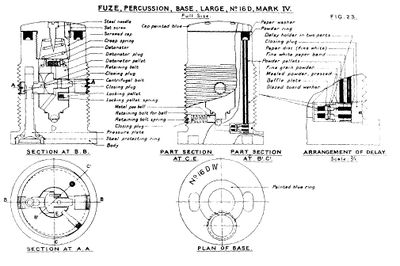British Shell in the Great War
Pre-War
As early as 1907 the Assistant Director of Naval Ordnance, Frederick C. T. Tudor, wrote to the First Lord of the Admiralty, Lord Tweedmouth, that, "There has been lately a question raised as to slight flaws in [Lyddite] shell extending further than hitherto believed, and a stricter form of examination is under consideration."[1]
Great War
On 7 August 1916, Vice-Admiral Farquhar was appointed to a committee to "enquire into and report on the question of the different types of projectiles in use in the Fleet and the proportion in which they should be supplied." This committee worked until 25 April, 1917,[2] shortly after the Shell Committee started work to study the penetration deficiencies of British shell, initially under the direction Vice-Admiral Arthur Henry Limpus as President.
Fuzes

Developed by order of the Shell Committee, 1917-1918.
Image: Admiralty Technical History. Volume 3. Part 29.
Footnotes
- ↑ Tudor to Tweedmouth. Letter of 15 August, 1907. Tweedmouth Papers. National Museum of the Royal Navy, Portsmouth. MSS 254/50x.
- ↑ Farquhar Service Record. The National Archives. ADM 196/38. Book 2. f. 446.
Bibliography
- McCallum, Iain (2003). "The Riddle of the Shells, 1914-18: The Approach to War, 1882-1914." Warship 2002-2003. Ed. Antony Preston. London: Conway Maritime Press. pp. 3-25. ISBN 0851779263.
- McCallum, Iain (2004). "The Riddle of the Shells, 1914-18: Part Two: The Test of Battle, Heligoland to the Dardanelles." Warship 2004. Ed. Antony Preston. London: Conway Maritime Press. pp. 9-20. ISBN 0851779484.
- McCallum, Iain (2005). "The Riddle of the Shells, 1914-18: Part Three: Disappointment in the North Sea." Warship 2005. Ed. Antony Preston; John Jordan. London: Conway Maritime Press. pp. 9-24. ISBN 1844860035.